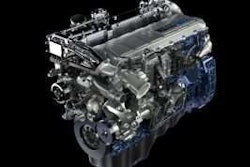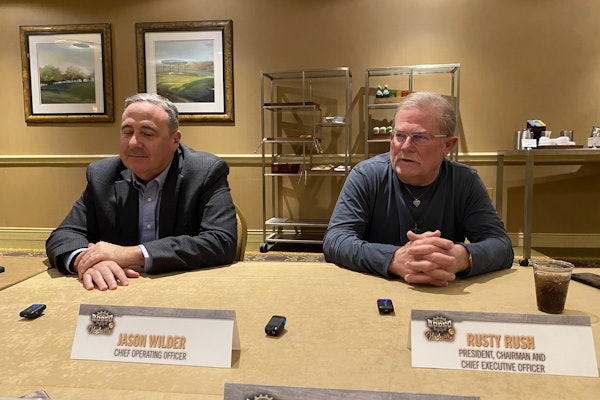With used truck sales stagnating and values tumbling, moving a used truck has become harder than ever.
For dealers who remain committed to the ‘old-fashioned’ way of selling this is especially true. Today’s used truck buyer has evolved, and as such, so to must a used truck seller.
One way dealers can improve their chances of selling used trucks is by inspecting them and correcting deficiencies “before putting the trucks on the line,” says Rick Wilson, medium-duty sales manager at Jenkins Diesel. “This will ensure the customer gets the best value for his money, and enables the dealer to sell on value rather than on price which increases gross [profit].”
Another important tool is the Internet.
Peter Trench, vice president of national accounts at Manheim, sees the Internet as the future of merchandising and selling used trucks.
“Potential buyers are using the Internet to search for vehicles, research their purchase options and even to research the dealer’s reputation,” he says. “All this will occur before they make the first contact with the dealer. Having a solid, well thought out Internet strategy is critical for dealers.”
A dealer’s Internet strategy should have two pieces: inventory sourcing/wholesale and retail.
Trench encourages dealers to use the Internet to source inventory, research it and buy it. “This gives the dealer greater access to more potential inventory and information to make decisions,” he says.
In order to be successful retailing used trucks using the Internet, Trench also says dealers need to have a solid website, good listing guidelines and a plan for search engine optimization. “Make sure the customer can find your inventory and that your store comes at or near the top of a Google search.”
Lots of good pictures or videos are another important piece of showing your trucks online. “Support that with a good write up on the points that will resonate with potential customers,” Trench says.
In addition, make sure that when customer inquiries come in someone responds to them quickly. “The Internet is instant; the response needs to be fast to the inquiries, too,” he says.
David Yglesias, dealer principal at Palmetto Ford Truck Sales, says marketing of used trucks has transitioned 100 percent from traditional media to electronic using web sites as well as social media.
Another component to a dealer’s used truck strategy is auctions. “Access to good, quality used truck inventory is a challenge for dealers and using the auction is a proactive way to face the challenge,” Trench says.
“When a dealer has an aged unit to dispose of, auctions provide the best way to maximize the value of the asset,” he says. “Putting the truck in a bidding environment will get the true value of the truck.”
Kyle Treadway, president at Kenworth Sales Company, believes auctions are useful when a dealer “is burdened with a large group of like-spec’d units and needs to move them out fast. An auction also can be helpful when a unit is aged beyond its attractive life in [your] inventory and must be turned to make room for something else younger and more attractive.
“In other words, an auction will likely not provide the dealer with gross profit on a sale, but it will improve his cash flow,” Treadway says.
There are some things dealers can do to more effectively sell used trucks and increase the profitability of their used truck department.
It starts when a dealer takes a used truck into his inventory. A dealer needs to calculate the price he is going to purchase the truck for based on the price he can sell it for, how quickly he can sell it and at what profit level he wants, Treadway says.
“We all need to take trade-ins to keep customers buying new equipment, and we typically make little or no profit on reselling these trades,” he says. “So we must actively seek out and purchase inventory to absorb the overhead expense, compensate for losses on the sales of trade-ins and generate some net profit at the end of the day.”
He adds this all must be done quickly. “That means taking any losses promptly rather than waiting for the specific buyer who will take your ‘ugly baby’. The popular catch phrase, turn and earn, still applies.”
Trench says the first thing dealers need to do is be in touch with their markets, know what is selling and what isn’t and what the competition is doing.
“Second [they] need to have an effective Internet strategy for merchandising and marketing used trucks. Buyers are aggressively using the Internet and in most cases this is [a dealer’s] first impression with a new customer,” he says.
“Third, pricing for velocity sales is important,” Trench says. Velocity sales is focusing on turning inventory quickly and it requires market knowledge and discipline in inventory sourcing, retail pricing the types of vehicles in inventory and how long aged units are held, Trench explains.
“It is metric driven and the dealer needs to know that total cost of acquiring a used truck. Tracking the turn rate of each vehicle and vehicle type is essential. Using a velocity pricing strategy will increase your sales volume and your total gross profit for the month,” he says.
He adds that a dealer can increase his used truck sales volume without increasing the size of his inventory.
While often viewed as a necessary evil, if handled properly used trucks can not only be profitable themselves but can help generate additional revenue in the parts, service and finance departments as well.







